
Welcome to the 19th edition of First Nations News & Views. This weekly series is one element in the “Invisible Indians” project put together by Meteor Blades and me, with assistance from the Native American Netroots Group. Our edition is here. In this edition you will find an Aaron Huey update, an important petition from the Lakota People’s Law Project, a look at the year 1812 in American Indian history, three news briefs and some linkable bulleted briefs. Click on any of the headlines below to take you directly to that section of News & Views or to any of our earlier editions.
By navajo

Community Storytelling Project | The Moment: Cover Potential | Map: The Lost Land
From 10,000 Words:
The latest cover of National Geographic features the story of the Pine Ridge Indian Reservation, home to the Oglala Lakota. Alexandra Fuller’s well-written piece of long form journalism plus Aaron Huey’s series of striking photographs is standard fare in the magazine by now, but this cover story included a new form of storytelling. Huey, who has spent the past seven years documenting and befriending the Lakota teamed up with Jonathan Harris, creator of Cowbird, to launch the Pine Ridge Community Storytelling Project. Cowbird is a storytelling platform focused on personal narratives rather than quick status updates, and the collaboration is an attempt to give the people of Pine Ridge a chance to tell their own stories. Users can use photos, audio and text on one seamless platform that attempts to build a library of human experiences.
You can read a full interview with Aaron Huey here.
The community story-telling project was born of the frustration Aaron Huey had as a journalist having to choose the most sensational images to publish but ones he felt necessary to bring attention and raise awareness about poverty in Pine Ridge. After these photos were published, Huey received two huge envelopes of letters from Pine Ridge high school students asking him to tell their stories of success and happy family examples. On a subsequent visit, an elder told Huey she was disappointed in his coverage. It was at this time he, having learned the history of the Oglala Lakota, had shifted from journalist to advocate. (More background below on Huey’s work.) He decided to take their side in telling the story of the broken treaties.
Huey was able to focus on this project as a Stanford University Knight Journalism Fellow this past school year. A grant from the John S. and James L. Knight foundation funded the project and is allowing him to send multiple people to help residents of Pine Ridge upload their stories. He hopes to get schools in every town on Pine Ridge involved as well as Oglala Lakota College. Another goal is more songs and Lakota language stories. The goal is 500 stories by year’s end. There are more than 200 now. Be sure to listen to some of these.
This is the interface of the Pine Ridge Community Storytelling Project:
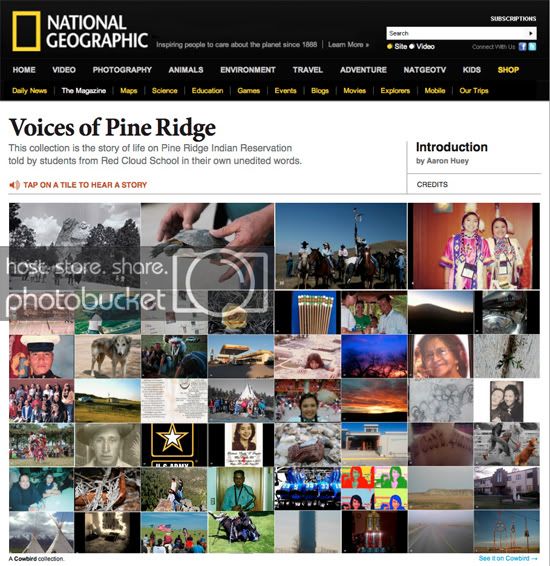
A new Shepard Fairey collaboration piece has been produced and will be for sale in packs of 10 for public display. The 450 signed prints sold out in minutes on July 26. The actress Daryl Hannah is working closely with Huey to get thousands of these posters pasted up across the United States.
From Fairey’s website:
“I made this image in collaboration with National Geographic Photographer Aaron Huey in support of www.honorthetreaties.org and their efforts to educate the public about Native American Treaty rights. This is our third project together and was built directly off of the mural we did on the Baracudda wall on Melrose last Fall. See the full installation here. Our first poster project went up in a dozen American cities in 2011.”
As promised, here is Eric Becker’s short film about Aaron Huey’s work. In the 14-minute video below, you’ll see footage of the Black Hills Are Not For Sale installation in Los Angeles, background on how Huey started this project and why he chose to become an advocate for Pine Ridge.
video will not embed, see links below
Honor the Treaties | The Film from Eric Becker on Vimeo A portrait of photographer Aaron Huey’s work on the Pine Ridge Reservation
Featuring Shepard Fairey
World premiere opening night ShortsFest, Seattle International Film Festival 2012, Official Selection
Directed by Eric Becker / weareshouting.com/
Produced by Scott Everett
Honor the Treaties: www.honorthetreaties.org
All photos (c) Aaron Huey / www.aaronhuey.com
With Artwork by Shepard Fairey and Ernesto Yerena

Aaron Huey is a contributing editor for Harper’s Magazine and has gone on numerous assignments for National Geographic around the world. He emailed me in 2010 to share his TED talk. I was so moved by it that I featured it in a diary, Pine Ridge: American Prisoner of War Camp #334.
Huey’s TED talk was a result of getting to know the Lakota people on the Pine Ridge reservation in South Dakota and photographing them to raise awareness of their continuing fight for survival. In the talk he recounts the history of the Lakota starting with 1824. He details the devastating massacres and “more than a century later, the current condition of Pine Ridge reveals the legacy of colonization, forced migration, and treaty violations.” His powerful video is embedded at the link above, I urge you to watch it.
Huey created the website Honor the Treaties to house this video and educate visitors about the history of broken promises. Then he started The Pine Ridge Billboard Project. A collaboration with the street artists, Shepard Fairey and Ernesto Yerena. Three beautiful posters were created and links were provided so anyone could download the images, and print and post them in their own cities.

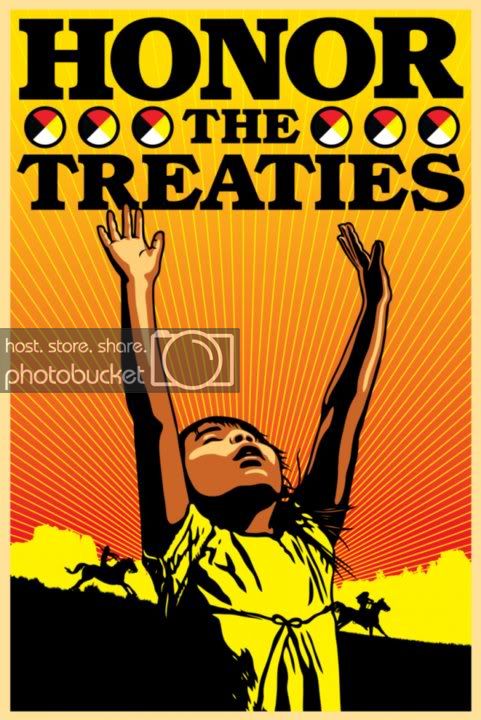
The posters went up in numerous cities. The most impressive installation of this project was a billboard on Melrose Avenue in Los Angeles. Meteor Blades and I watched for five hours as the work was completed by Huey, Fairey and some of their helpers.
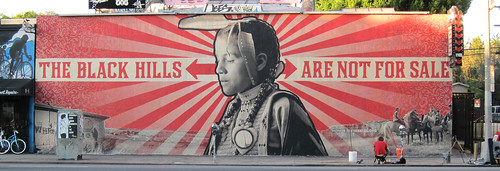

By Meteor Blades
Most recently, it’s been called the Fort Dearborn Battle after having been for nearly two centuries called the Fort Dearborn Massacre. Even today, 200 years after the event that cost the lives of 52 white settlers and soldiers as well as 15 Indians on August 15 at the beginning of the War of 1812, people continue to argue both about what happened and about the meaning of it.
Since the 1850s to near the end of the 20th Century, the popular version of what happened that summer of 1812 in what is now the Chicago Loop, was Wau-Bun: The Early Day in the Northwest,, a book written by Juliette Magill Kinzie. She was married to a son of a fur trader who had been at Fort Dearborn when the killings occurred. The book had literary flair. And many fabrications. Although one Potawatomi retort to the conventional version by Simon Pokagon was published in 1896, corrective accounts by scholars weren’t published for more than 60 years, most notably by Milo M. Quaife in 1913. None gained the popularity of Kinzie’s book. Among other things noted in Quaife’s Chicago and the Old Northwest, he wrote of Kinzie: “Accuracy of statement is clearly not her forte, while to the objective detachment of the historian she is a complete stranger.”
Historical events can never be understood outside the context of the flow of other events around them.
Fort Dearborn, at the mouth of the Chicago River, was built there as the westernmost outpost of the United States in 1803 on landed ceded under coercion. It was a combination of fortress and trading post in a land sparsely populated by frontiersmen and white settlers amid thousands of Indians of several tribes, many of them refugees and exiles of the Iroquois wars further east. The Potawatomi (in their own Algonquian language, Bodéwadmi, “keepers of the fire”) had lived in the region for at least 175 years when Fort Dearborn was built, having originally inhabited areas north of Lake Huron and Superior. They were closely allied with the Ojibwa and Ottawa.
The Northwest Indian War was brought to a close by the Treaty of Greenville in 1794. It forced the surrender of Indian lands of the Ohio Valley and elsewhere to the United States, including six square miles around the mouth of the Chicago River where Fort Dearborn would be built. There was a 10-year peace with little pan-tribal resistance to the growing spread of white settlers. Many Indians and their leaders chose to make cultural adjustments. However, not all agreed. They became angrier each time settlers squatted on land supposedly permanently given to the tribes, land then ceded as additional treaties were signed. Resistance grew. Starting in 1805, two Shawnee brothers, Tenskwatawa, known as “The Prophet,” and Tecumseh, rejected much of the white world, especially including alcohol, urged an end to land cessions and built a coalition among Indians from more than a dozen tribes.
The objections to the latest land cessions sought by Indiana Territory Gov. William Henry Harrison-who operated against the direct orders of President James Madison by making deals guaranteeing large payments to tribes-would in 1811 turn into Tecumseh’s War. Harrison gained the fame that would later help propel him into the Presidency when his militia defeated Tecumseh at the Battle of Tippecanoe that same year. That clash, which many Americans saw as part of British efforts to stir up “Indian trouble” on the frontier, was one of many bits of kindling leading to the War of 1812.
When that war officially started in June 1812, the British immediately captured Fort Michilimackinac (Mackinac) without a shot. With no ability to resupply the outpost, the American general at Fort Detroit William Hull ordered the commander at Fort Dearborn, Captain Nathan Heald, immediately to evacuate his 54 troops and the 39 civilians, including nine women and 18 children.
Nobody knows what crossed Heald’s mind when he read that order. But he must have at least thought briefly that, given the hundreds of Potawatomi and other warriors visible around the fort, it might be better to wait out a siege. He nevertheless chose to obey, first making a deal with the Indians that, in exchange for safe passage, they would be given all the goods inside the fort.
As part of her blast at Heald’s “incompetence,” Juliette Magill Kinzie invented a quote from Hull’s order in her 1856 book even though she had never seen it. The words “if practicable” were included in the order, she wrote, and clearly evacuation in such circumstances would not have been practicable in her view, a reflection no doubt from her husband, whose father was known as a wily trader in his days at Fort Dearborn.
The actual order was kept for posterity, so we know what it actually said. In it is a key point that some amateur and professional historians have said may well have contained the spark that led to the killings that day in August 200 years ago. General Hull told Captain Heald to destroy the stores of munitions and alcohol before leaving. The problem with that is that Heald had made other arrangements with the Potawatomi. Some historians believe the Indians felt the munitions were part of the deal and that the captain had broken it.
Heald ordered the column of evacuees-which included his son-in-law, Captain William Wells, leading 15 Miami Indian escorts-away from the fort. Whether the Potawatomi planned to attack regardless or they decided the deal was off because of the destruction of powder and bullets, the clash took place about a mile and a half from the fort. Heald, presuming an attack was imminent, ordered his troops to advance over the dunes and fire the first shot. Fifteen minutes later, 26 regulars, 12 militia, two women, 12 children and 15 Potawatomis were dead. Fifty-one others from the fort were captives.
During the fight, two of the women and most of the children were tomahawked to death. One account later claimed a single warrior killed them all. Black Partridge, a Potawatomi who had opposed the attack, rescued the wife of Heald’s second-in-command Lt. Linai Helm by dragging her away during the fight and pretending to drown her. She survived and was later ransomed. (His act was later commemorated with a sculpture that has since become the subject of political and artistic dispute and is now stored in a warehouse.)
Another person given great credit by both historians and people at the time was Captain Wells. Although his Miami allies fled immediately, he is said to have killed several Potawatomi in a desperate attempt to reach the wagons where the women and children were riding. All accounts say the Indians who killed him also lauded his bravery. With him dead on the ground, they cut out his heart instantly, dividing it into pieces and eating them to gain for themselves some of his courage.
The night after their capture, some soldiers were tortured to death. A few other captives died as well. But most were subsequently ransomed, including six-month-old Susan Simmons, who was the last survivor of the killings when she died in 1900.
Simon Pokagon, the Potawatomi whose father was alive when Fort Dearborn still stood, wrote in 1896:
It is true that the Indian retaliated, and was in many cases the aggressor, if we can call people the aggressors who object to having their native land taken from them by aliens. […] Of the savagery and brutality exhibited by the Indian in many cases, I would merely observe that it is manifestly unfair to judge them by the standards of a people who have enjoyed Christian civilization for many centuries and who have behind them the lessons and warnings, the glory and the gloom of Roman, Grecian, Syrian, Chaldean, and Egyptian civilizations. Moreover, if one calls to mind the methods which marked the terrible religious struggle of the fifteenth and sixteenth centuries in Europe, and will remember how human ingenuity was taxed to its utmost to devise methods of horrible torture which were remorselessly meted out by those claiming to be Christians to others claiming to be Christians, he will, I think, feel it wisest to pass very lightly over the charge of excessive cruelty on the part of those he flippantly terms savages. Had the Indian submitted more tamely he would have been characterized by this same self-engrossed class, who delight in echoing the brutally false phrase that “there is no good Indian but a dead Indian,” as cowardly and unworthy of the land which for unnumbered generations had been the land of his fathers.”
In 2009, a new park was dedicated to commemorate the event. It is named The Battle of Fort Dearborn Park. Not everyone in Chicago who paid attention to the establishment of the park was happy about it. Some called it part of unfair revisionist history, arguing that what occurred during the evacuation of Fort Dearborn was a massacre and should continue to be called one.
Who knows what the rescuer Black Partridge would have thought? During the rest of the War of 1812, Potawatomi villages were burned and hundreds of Indians slain. The Miami, allies of the United States, were also burned out. One excuse given is that they did not fight at Fort Dearborn. One such village was Black Partridge’s. He subsequently fought alongside the British. The treaty he signed in 1815 ending hostilities between the Potawatomi and the United States stated that “every injury or act of hostility…shall be mutually forgiven.”
In 1833, a treaty signed under duress forced the Potawatomi and other tribes to Nebraska and elsewhere. Hundreds of members of the tribe held a final dance near the city in 1835 before they began their journey into exile. Many Potawatami now live in the area again.
Chicago Alderman Edward Burke earlier this year pushed for a “Day of Remembrance and Reconciliation” for the 200th anniversary. But his proposal was not gladly received by a number of Indians, particularly when he talked of smoking a “peace pipe.” A stereotypical resolution, said one critic, in which three whites were singled out for their sacrifice that day but not one Potawatami was mentioned.
In Chicago and elsewhere, there are still people on both sides who are not eager to forgive or reconcile.
•••
Among my sources:
Introduction written by Nina Baym for the 1992 edition of Wau-Bun: The Early Day in the Northwest by Juliette Magill Kinzie.
The True Story of the Deadly Encounter at Fort Dearborn by Geoffrey Johnson.
15 bloody minutes that shaped a city by Ron Grossman.
What Happened at Fort Dearborn by Lee Sandlin

Lakota People’s Law Project Petition to Rescue Indian Children
Action: Please Sign This Petition and Share Widely
Meteor Blades wrote a compelling piece last October about an NPR three-part series revealing that the State of South Dakota is kidnaping Lakota children and forcing them into white foster care. The state, in an effort to balance its budget, has found a way to obtain over $100 million in Federal funding each year by taking Indian children from their families. Native American children are removed in disproportionate numbers from their homes all over our nation, with South Dakota being one of the worst states.
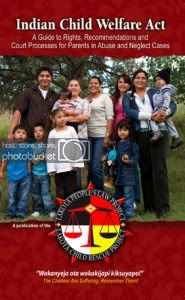 Lakota People’s Law Project has developed
Lakota People’s Law Project has developeda unique resource for dealing with Native American
children seized by the state
Today, one of the greatest threats to our people is the massive theft of Lakota, Dakota and Nakota children by state authorities. The state of South Dakota couldn’t have cared less about Native American children until there were millions to be had, and today the state receives almost $100 million per year from the federal government for foster care services – and $12,000 for each Indian child moved from foster care into adoption. The result: between 2001 and 2009 more than 5,000 Native children were removed from their families and, in direct violation of the Indian Child Welfare Act (ICWA), 95 percent of them were put into white and state-run care. These actions tear at the fabric of our kinship society, cutting children off from their traditions and continuing the cycle of injustice.
We’ve made a strong connection with the Lakota People’s Law Project (LPLP), a nonprofit that uses law, public education and grassroots organizing to fight the injustices perpetrated against their people. Right now, they are preparing to file a federal civil lawsuit to rescue their children.
Madonna Thunder Hawk, (Cheyenne River Sioux) the tribal liaison for LPLP, wrote a Daily Kos diary agt the beginning of August reporting that as a result of the NPR series “six members of the House of Representatives-four Democrats and two Republicans-sent letters to the assistant secretary of Interior for Indian affairs, Larry Echo Hawk. Their letters demanded that the Bureau of Indian Affairs (BIA) respond to the claims made by the NPR story and propose a plan to improve the situation in South Dakota. In response, Echo Hawk replied to the congressmen, pledging to hold a summit in South Dakota about Native American foster care. Nine months have passed and nothing has been done to keep that pledge.” Echo Hawk promised the ICWA summit would take place in early 2012. Echo Hawk left the BIA in April 2012 to take a high-ranking postion with the Mormon church.
The ICWA directors from all of South Dakota’s reservations recently met to prepare a request that the BIA host a summit, as promised. The Lakota People’s Law Project has created a petition to support the ICWA Directors in their call for this summit and in the struggle to rescue the children. Please sign the petition to the BIA, and you can help spread the word.
Meet Madonna Thunder Hawk, an original member of the American Indian Movement and a co-founder of Women of All Red Nations (WARN), and learn more about this effort:

Thrash Metal Band Testament’s New Album Features Native Blood
By navajo
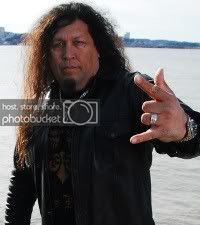
-Photo Courtesy of
Nuclear Blast Records
Chuck Billy (Hopland Band of Pomo Indians), Testament’s vocalist, features his Native heritage in the band’s latest released album Dark Roots of Earth. The video for Native Blood tells the story of a young boy who endures taunting “war whoops” from his classmates for being Indian. He seeks guidance and cultural support from his elders. The same boy in his teens has his girlfriend taken away by her white father. The boy grows up to organize his community against a takeover of their sacred lands. It opens with a quote from the great Oglala Lakota war chief Crazy Horse, “Somewhere a good man must rise from the young ones among us.”
From the lyrics:
I’m one in this world, so stay outta my way. My voice will be heard. So strong. I won’t be afraid. I got something to say. My voice will be heard. So loud, native blood, my native blood.
The video ends with a quote from Peter Blue Cloud(Mohawk, “We natives are guardians of the sacred place.”
The making of the video can be viewed here. It was shot on the Billy Ranch on the Hopland Indian reservation in Northern California. His community gave the shoot its full support and many tribespeople were featured in the video dancing and wearing traditional Pomo dress.
The video is very well done:
Billy was the first Native American entertainer to be permanently featured in one of the Hard Rock Hotel and Casino’s memorabilia displays in Albuquerque, N.M. He was also featured last year in a Smithsonian National Museum of the American Indian exhibit Up Where We Belong: Native Musicians in Popular Culture.
Here is an interview excerpt from Noisecreep:
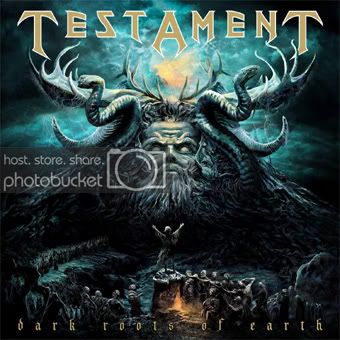 Testament’s Cover Art for
Testament’s Cover Art forDark Roots of the Earth
-Photo Courtesy of
Nuclear Blast Records
“I was born in Oakland, Calif., and for the first five years was raised in Los Cerritos, Calif. After that, we moved to Dublin, Calif., and I pretty much grew up there. My father owned two properties there, and I remember going to the reservation a lot as a kid. When my father retired, he moved there permanently.”
The singer told us life on the Hopland reservation during the ’70s and ’80s was radically different from the existence he knew back at his Dublin neighborhood. “There was just so much freedom on the reservation. I hate to say it, but they were just a bunch of wild Indians [laughs]. It was crazy back then. Our tribe and reservation is really small, and before we ever had a casino on the land, there wasn’t a lot of hope. There wasn’t any money around, and it just felt desperate. It was dire, especially with education and basic resources like that. The kids didn’t even have the basic stuff other kids have in the rest of the country. So a lot of kids didn’t even bother going to school.”
Billy said the opening of the Sho-Ka-Wah Casino on his tribe’s land saved his reservation, and its people. “My father was on the tribal council, and he and a lot of other people, had a lot to do with bringing in the casino. Once that came in, it cleaned everything on the reservation up. Not just money for education and the water system, but also programs for things like keeping our language alive.”

Pennsylvania Town, Sons Fight Over Where Jim Thorpe’s Remains Should Rest
By Meteor Blades
Ask almost about any American who Jim Thorpe was and you won’t get the blank stare so often elicited when someone renowned among American Indians is mentioned. A century ago, in Sweden, Thorpe ran two races that made him famous, delighted Indians of all tribes (his own ancestry was Sac and Fox from Oklahoma), and for the first time made the USA a real competitor in the Olympic Games. Thorpe was given a hero’s welcome in New York City. The first sports superstar.
He was already making waves at Carlisle Indian Industrial School when he led the football team there to an 11-point win over Harvard in 1911. His coach, Pop Warner, urged him to compete in the Olympics, a contest he hadn’t even heard of. When he did, the world soon heard of him.
That year, 1912, marked the fifth modern Olympiad, and Thorpe took two gold medals, one for the pentathlon and one for the first ever decathlon. He won the latter by a huge margin. Handing him his medals and trophies, the king of Sweden told him: “You, sir, are the most wonderful athlete in the world.” It was 60 years before his record in the 1,500-meter run-4 minutes 40.1 seconds-was beaten, and then, not by much. And by then, he had been dead for 20 years after careers in baseball, then football, where he was spectacular, and basketball. In a nationwide survey in 1950, he was named the greatest athlete of the half century, way ahead of the second-place finisher, Babe Ruth.
Finally too old to compete, Thorpe went to Hollywood in 1930, played bad Indian parts in 70 or more mostly bad movies and put together a casting company to recruit Indians and lobby the studios to get real Indians to play Indian parts.
Long before that, however, his unparalleled accomplishments in Sweden were tainted by the fact he had played minor league professional baseball from 1909-1910. That went against the must-be-an-amateur rules. He was stripped of his medals and his winning performances were erased from the record books.
As Scott Bomboy writes, that was bogus even then.
Thorpe had played baseball for $2 a day, like other college students, but didn’t use an alias. In a letter of apology to officials, he said, “I hope I will be partly excused by the fact that I was simply an Indian schoolboy and did not know all about such things. In fact, I did not know that I was doing wrong, because I was doing what I knew several other college men had done, except that they did not use their own names.”
The apology wasn’t accepted.
So, he returned the medals. It later became known that he had never violated the amateur rules because the claim about his minor league “career” was filed after a reporting deadline in 1913.
Despite his professional career, things got rough financially at the end, even after a movie about him was made, Jim Thorpe-All-American ironically starring a fellow without a drop of Indian blood, Burt Lancaster. Thorpe died, age 64, in 1953. It wasn’t until 1983 that the International Olympic Committee, under intense pressure and with its amateur label having long since been abandoned in reality if not name, made duplicate medals for the family and made Thorpe co-equal with the silver medal winner of 1912. His records, however, were never reinstated.
And his remains still haven’t been returned home either. Three weeks ago, two of his sons testified in an arbitration hearing under terms of the Native American Graves Protection and Repatriation Act of 1990 to move his body back to Oklahoma from the town that now has it. That town is Jim Thorpe, Pennsylvania, a place he’s never been.
It wound up there in 1957 after having been stored in Los Angeles, Shawnee, Oklahoma and Tulsa for four years. Two towns, Mauch Chunk and East Mauch Chunk, agreed to merge and told the widow that in exchange for his body, they would name their new town after him, and as, Kate Buford tell the story:
There were grand promises of a hospital for athletes, the Pro Football Hall of Fame, a Jim Thorpe sporting goods factory.
None of them materialized.
But the fight over Thorpe’s body is still working its way through in a federal court. That is a result of a lawsuit initiated in 2010 by his son, Jack, to have his father’s remains returned to Oklahoma and buried on the remnants of the Sac and Fox reservation that, ironically, began to be dismantled the year Thorpe was born, 1888. The town decided to fight:
“This guy has a whole town named after him,” explains Jack Kmetz, president of the Jim Thorpe Area Sports Hall of Fame and lifelong resident of Jim Thorpe, Pa. “He has a bank named after him. He has a post office. He has his own ZIP code.”
Jack died last year, but Thorpe’s two living sons were testifying in court-ordered mediation in a federal lawsuit three weeks ago. It’s being heard in the U.S. District Court for the Middle District of Pennsylvania.
Among other things, the case has revealed that Thorpe’s third wife claimed his body “the night before a traditional Sac and Fox burial ceremony could take place in Oklahoma.”
William Schaub, the attorney for Jim Thorpe, Pennsylvania, told a local newspaper that a Supreme Court precedent was on the town’s side, since Jim Thorpe died in California.
“Burial has traditionally been governed by the states. Jim Thorpe was a resident of California,” Schwab said. “He died in California. This case should be governed by the California probate code which gave Jim Thorpe’s third wife the right to bury him as she saw fit. They are trying to trump state law.”
Ironically, as the court case continues over Thorpe, his body rests in a mausoleum that contains soil from his home in Oklahoma and dirt sent from the former Olympic stadium in Stockholm, Sweden.

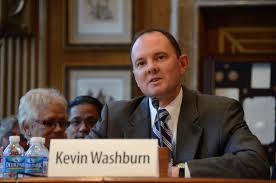 Kevin Washburn
Kevin Washburn
• Kevin Washburn Nominated for BIA Post: A 45-year-old member of the Chickasaw Nation who is an expert in Indian law and reservation gambling has been nominated by President Obama to fill the government’s top position at the Bureau of Indian Affairs. He has headed the University of New Mexico Law School since 2009. If he gains approval in the U.S. Senate, he will replace Larry Echo Hawk (Pawnee) who resigned as Assistant Secretary of the Interior for Indian Affairs to take a high position in leadership of the Mormon church.
“I’m deeply honored-it’s an exceedingly important responsibility to serve the nation’s Indian tribes and the Indian people,” Washburn told the Albuquerque Journal.
A biography posted at the University of Minnesota Law School website states:
[…]Washburn earned his law degree from Yale Law School in 1993, where he served as Editor-in-Chief of the Yale Journal on Regulation. Following law school, Professor Washburn clerked for Judge William C. Canby Jr. of the United States Court of Appeals for the Ninth Circuit. In 1994, Professor Washburn joined the U.S. Department of Justice through the Attorney General’s Honors Program. At Main Justice, he litigated cases involving Indian tribes, mostly in the context of environmental and natural resources law. In 1997, Professor Washburn left Main Justice to become a federal prosecutor in New Mexico, where he primarily prosecuted violent crimes arising in Indian country and referred by the FBI. In 2000, Professor Washburn became the General Counsel of the National Indian Gaming Commission, the independent federal regulatory agency that regulates Indian gaming nationwide. […]
He spent most of his youth in small towns in Oklahoma within the original boundaries of the tribe’s former reservation. He attended the University of Oklahoma, where he earned a bachelors degree in economics with honors.
Among his many academic publications, Washburn has listed the following as representative: The Legacy of Bryan v. Itasca County: How an Erroneous $147 County Tax Notice Helped Bring Tribes $200 Billion in Indian Gaming Revenue (2008); Restoring the Grand Jury (2008); American Indians, Crime, and the Law (2006); and Federal Criminal Law and Tribal Self-Determination (2006). He has served as a trustee on the Law School Admission Council from 2006 to present; as a member of the Ad Hoc Advisory Committee on Native American Sentencing Issues of the United States Sentencing Commission from 2002 to 2004; and as a member of the Board of Directors of the Innocence Project of Minnesota from 2002 to 2003.
Washburn is married to Elizabeth “Libby” Rodke Washburn, who currently serves as the state director for U.S. Senator Jeff Bingaman (D-New Mexico), and they have two children. A Democrat, Washburn has contributed $3,050 to Democratic candidates and causes, including $525 to ActBlue in 2009, $525 to Sen. Michael Bennett (D-Colorado) in 2009, and $2,000 to John Kelly’s unsuccessful campaign for Congress in New Mexico’s 1st Congressional District in 2000. Libby Washburn has contributed $1,250: $250 to Dave Obey (D-Wisconsin), who was U.S. Representative for Wisconsin’s 7th Congressional District from 1969 until 2011, in 2009, and $1,000 to Sen. Bennett in 2010.
-Meteor Blades
• Bill to Permit Foreign Investment on Tribal Reservations Fails: A bill that would have allowed some experiment with foreign investments on American Indian reservations has failed in the House of Representatives because it could not obtain the two-thirds vote needed for fast-track legislation. The bill’s sponsor, Tom Cole (Chickasaw), an Oklahoma Republican, said opposition came from representatives who saw it as offering too good a deal to Turkey. Cole said the Turks were the only foreign nationals who had shown any interest in investing on reservations.
-Meteor Blades
• Tribe revitalizes Lakota language through dance: Fluent speakers of the Lakota language among the Rosebud Sioux in southern South Dakota are aging and dwindling. Loss of language is a problem among American Indians throughout the nation. Altogether among all Lakota on their several reservations in North Dakota and South Dakota, only about 6,000 people speak the language with any fluency. That’s less than 14 percent of the whole population. The average age of Lakota speaker is 60. The Rosebud tribe has sought various ways to keep the language alive among children. One of those focuses on song and dance. Gale Spotted Tail (Sicangu Lakota), who directs the tribe’s Child Care Service’s Song and Dance Project, says, “It’s putting identity and pride back into the people.” The program teaches families how to make accurate, detailed ceremonial regalia and teaches the intricate dances to the children so they can perform in the annual wacipi, or powwow. The effort creates a special bond between children and the older generations.
-Meteor Blades
• Tribes Won’t Have to Reimburse Feds for Divided Land Government Buys for Them: The Interior Dept. ended a major worry last week for American Indian tribes who will use a settlement to buy up divided lands and reincorporate them into communally tribal property. Some $1.9 billion of a $3.4 billion settlement in the Elouise Cobell Niitsítapi (Blackfoot Confederacy) lawsuit has been set aside to purchase land that was alloted to individual tribal members from 1887 until 1935 under the Dawes Act.
Although the allotments started out as 80- to 320-acre parcels to individuals and single families, over the generations they have become entangled in fractional ownership with dozens, sometimes hundreds of individuals, owning a piece. This makes their use for anything practical very complicated. The allotment system was originated as one means of breaking up the tribes and assimilating Indians into the overall U.S. population by making them farmers and ranchers. Almost immediately, despite laws forbidding the practice, thousands of allotments were sold off cheaply to non-Indian owners, which has created a patchwork of ownership within the boundaries of many reservations.
Under previous law, liens could be placed against the land purchased for the tribes by the government. If that were the case with the Cobell settlement, it would mean they would end up having to reimburse Washington for the hard-fought money agreed to in the settlement. That deal was made to repay the for more than a century of mismanagement of those lands by the Bureau of Indian Affairs.
-Meteor Blades
• NBC’s Matt Lauer Spouts “Indian-Giver” During Olympics Coverage: It was a silly segment to begin with, like so much of NBC’s coverage of the 2012 Games, but Lauer made it even worse with his casual slur. So much so that Sonny Skyhawk (Sicangu Lakota) devoted his entire “Ask N NDN” column in Indian Country Today Media Network to blasting Lauer and urge readers to email or otherwise contact NBC and “The Today Show” seeking an apology. Noting that it was a century ago that Jim Thorpe (Sac and Fox) had brought honor and fame to not only his tribe, but also all Indians and the U.S. by winning two gold medals in Sweden in 1912, Skyhawk wrote:
These memories of my hero have been on my mind as I have enjoyed these Olympic Games-until I heard those ugly words uttered by Matt Lauer:
“DON’T BE AN INDIAN GIVER.”
I was frozen and dumbfounded, as if someone had slapped me in the face. I couldn’t believe what I had just heard. I paused and then recalled the countless hours and years I and many of my colleagues had spent, attending diversity meetings in which we discussed and agreed on the need for all cultures to respect each other. We agreed that all humans deserve to be given respect when it has been earned, and that we, American Indians, have earned that respect many times over.
All of that came crashing down when I heard that idiotic phrase.
Skyhawk wrote a letter to the president of NBC News and urged readers to take similar action or contact others at the network.
-Meteor Blades
• Border Patrol Finds Ancient Pots in Desert:
Archeologist working in desert alcove.On patrol for undocumented immigrants in ever-more remote areas of the desert Southwest, agents of the U.S. Border Patrol stumbled onto a find that has made archeologists happy: four ancient clay pots in two rock alcoves in the Organ Pipe Cactus National Monument. The largest of the pots is thought to be an olla, a water jar. The agents may have saved the pots from looters who sell such items on the black market. Pot hunting is illegal but common on federal and state land.
Scientists say the pots, which were found whole instead of in the usual shards common to most such discoveries these days, are hundreds of years old, perhaps as many as a thousand. Although the area, which the government declined to identify specifically, is close to the Tohono O’odham reservation, what tribe made these items, or when, is unknown. The prehistoric people here are called the Hohokam.
After a member of the Tohono O’odham Nation, who trace their ancestors to the Hohokam, conducted a ceremony, National Park Service archaeologists removed the pots and transported them to the Western Archaeological and Conservation Center in Tucson, which is administered by the National Park Service.
The center, which is not open to the public, contains more than 24,000 artifacts found on national parks and monuments in the western region.
-Meteor Blades
• Super PAC Tied to Copper Corp Opposes Navajo Candidate:
Wenona Benally BaldenegroOne of the founders of the Super PAC “Restoring Arizona’s Integrity” is GovGroupAZ, a Phoenix-based consulting firm that lobbies for the copper company ASARCO. The company has a history of massive pollution, one of its contaminated smelter operations having been considered the worst of the nation’s 1,200 Superfund sites. RAI is supporting conservative Democrat Ann Kirkpatrick for congresswoman in First District of Arizona against progressive Wenona Benally Baldenegro (Navajo) in the state’s upcoming primary election. Baldenegro has the support of the United Steelworkers, who represent most of Asarco’s workers. Kirkpatrick served a single term (2009-2011) as the representative from the district, which has the highest percentage of American Indians of any congressional district in the United States, 22 percent.
Although never officially a member of the congressional “Blue Dog” caucus, Kirkpatrick voted like one during her single term. She has an ample collection of powerful backers. Despite its vow to stay out of primaries, one of those is the Democratic Congressional Campaign Committee, which came out in her favor thanks in part to the “ex” Blue Dog now heading the DCCC, Steve Israel. Baldenegro had been endorsed, among others, by 7th District Rep. Raul Grijalva, chairman of the Congressional Progressive Caucus.
-Meteor Blades
• Judge’s Ruling Brings “Fighting Sioux” Fight to an End: U.S. District Judge Ralph Erickson dismissed a year-old lawsuit by six American Indian students alleging damage from the use of the “Fighting Sioux” nickname and logo at the University of North Dakota. The judge noted that the statewide vote in June that had overwhelmingly sent the name into retirement effectively put an end to any useful litigation in the matter.
-Meteor Blades
• Janna Ryan, Wife of Paul Ryan, Has Native Blood: The wife of the presumptive GOP nominee for the vice presidency has Chickasaw ancestry through her father, Dan Little. A tax attorney, she is not an enrolled member of the the Chickasaw Nation, which is based in Oklahoma, where it was forced to move from its home turf in Mississippi and Alabama in the 1830s. The tribe is the 13th largest federally recognized tribe in the nation. Janna Ryan is a cousin of Rep. Dan Boren, a Democrat, who is retiring after this term to become president of corporate development for the Chickasaws.
-Meteor Blades
• Onandaga Plan to Celebrate 400-year-old Treaty that Two Scholars Say is Fake: The Onandaga Tribe, part of the Iroquois Confederacy, is preparing for a major celebration of the Treaty of Tawagonshi of 1613 between the Dutch and Haudenosauneee, what the Iroquois call themselves. But two scholars say they proved the treaty is a fake a quarter century ago based on terminology, handwriting and the fact that the names of chiefs who signed the document are actually the names of villages. But the Onandagas say their own oral history of the treaty is backed up by a two-row wampum belt created at the time to commemorate the event and that the tribe still possesses. Spokespeople for the tribe say the two scholars are anti-Iroquois and seek to alter the centuries-long relationship between whites and the Haudenosaunee.
-Meteor Blades
-Meteor Blades
-navajo with a h/t to whomever
Indians have often been referred to as the “Vanishing Americans.” But we are still here, entangled each in his or her unique way with modern America, blended into the dominant culture or not, full-blood or not, on the reservation or not, and living lives much like the lives of other Americans, but with differences related to our history on this continent, our diverse cultures and religions, and our special legal status. To most other Americans, we are invisible, or only perceived in the most stereotyped fashion.First Nations News & Views is designed to provide a window into our world, each Sunday reporting on a small number of stories, both the good and the not-so-good, and providing a reminder of where we came from, what we are doing now and what matters to us. We wish to make it clear that neither navajo nor I make any claim whatsoever to speak for anyone other than ourselves, as individuals, not for the Navajo people or the Seminole people, the tribes in which we are enrolled as members, nor, of course, the people of any other tribes.
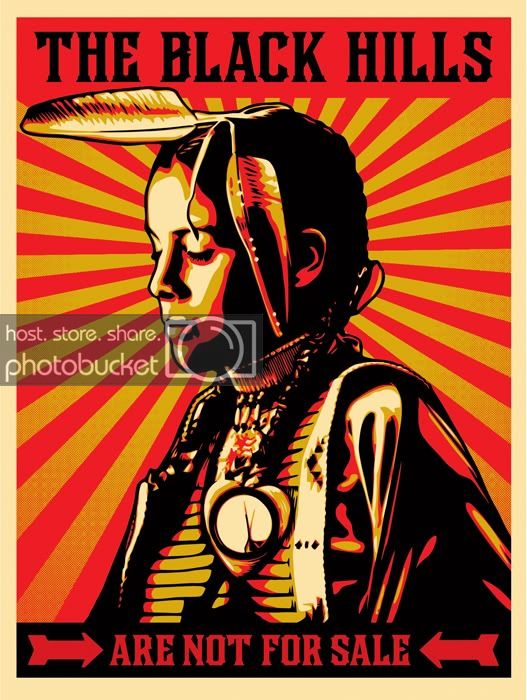
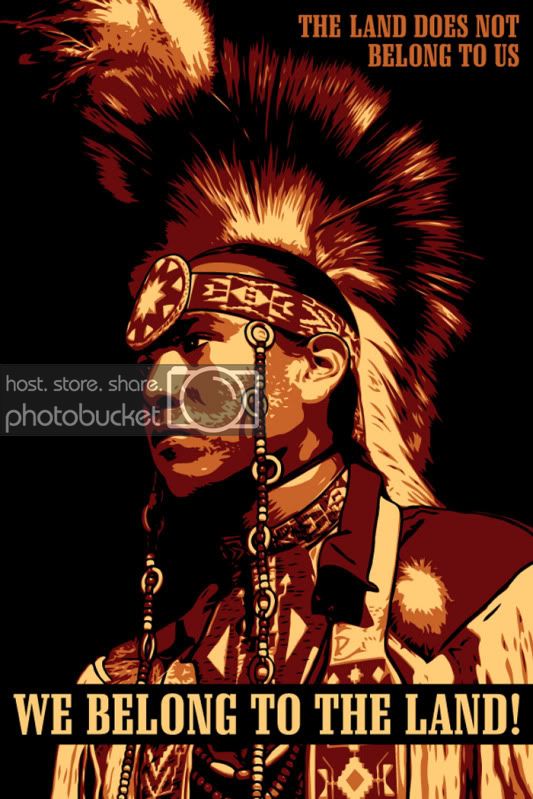
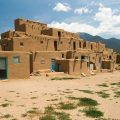
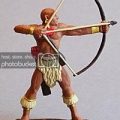
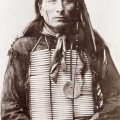
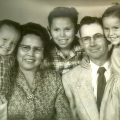
Leave a Reply